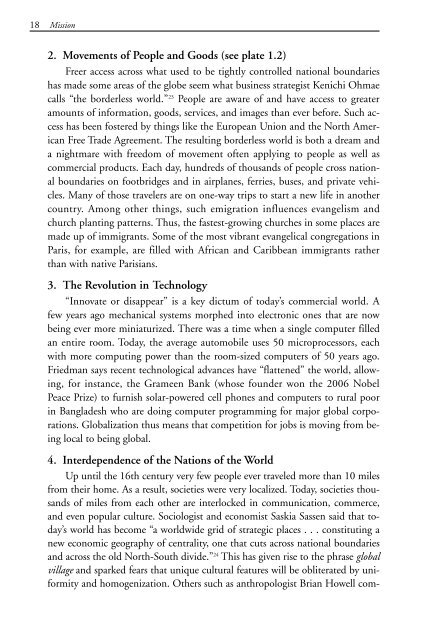discovering missions - Southern Nazarene University
discovering missions - Southern Nazarene University
discovering missions - Southern Nazarene University
Create successful ePaper yourself
Turn your PDF publications into a flip-book with our unique Google optimized e-Paper software.
245187 Disc Missions ins 9/6/07 1:04 PM Page 18<br />
18 Mission<br />
2. Movements of People and Goods (see plate 1.2)<br />
Freer access across what used to be tightly controlled national boundaries<br />
has made some areas of the globe seem what business strategist Kenichi Ohmae<br />
calls “the borderless world.” 23 People are aware of and have access to greater<br />
amounts of information, goods, services, and images than ever before. Such access<br />
has been fostered by things like the European Union and the North American<br />
Free Trade Agreement. The resulting borderless world is both a dream and<br />
a nightmare with freedom of movement often applying to people as well as<br />
commercial products. Each day, hundreds of thousands of people cross national<br />
boundaries on footbridges and in airplanes, ferries, buses, and private vehicles.<br />
Many of those travelers are on one-way trips to start a new life in another<br />
country. Among other things, such emigration influences evangelism and<br />
church planting patterns. Thus, the fastest-growing churches in some places are<br />
made up of immigrants. Some of the most vibrant evangelical congregations in<br />
Paris, for example, are filled with African and Caribbean immigrants rather<br />
than with native Parisians.<br />
3. The Revolution in Technology<br />
“Innovate or disappear” is a key dictum of today’s commercial world. A<br />
few years ago mechanical systems morphed into electronic ones that are now<br />
being ever more miniaturized. There was a time when a single computer filled<br />
an entire room. Today, the average automobile uses 50 microprocessors, each<br />
with more computing power than the room-sized computers of 50 years ago.<br />
Friedman says recent technological advances have “flattened” the world, allowing,<br />
for instance, the Grameen Bank (whose founder won the 2006 Nobel<br />
Peace Prize) to furnish solar-powered cell phones and computers to rural poor<br />
in Bangladesh who are doing computer programming for major global corporations.<br />
Globalization thus means that competition for jobs is moving from being<br />
local to being global.<br />
4. Interdependence of the Nations of the World<br />
Up until the 16th century very few people ever traveled more than 10 miles<br />
from their home. As a result, societies were very localized. Today, societies thousands<br />
of miles from each other are interlocked in communication, commerce,<br />
and even popular culture. Sociologist and economist Saskia Sassen said that today’s<br />
world has become “a worldwide grid of strategic places . . . constituting a<br />
new economic geography of centrality, one that cuts across national boundaries<br />
and across the old North-South divide.” 24 This has given rise to the phrase global<br />
village and sparked fears that unique cultural features will be obliterated by uniformity<br />
and homogenization. Others such as anthropologist Brian Howell com-

















